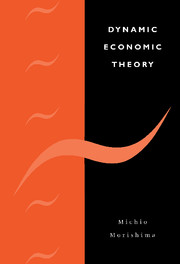Book contents
- Frontmatter
- Contents
- Preface
- 1 The method of dynamic analysis
- 2 Households' and firms' economic behaviour
- 3 Stability conditions for a temporary equilibrium: the linear case
- 4 Stability conditions for a temporary equilibrium: the non-linear case
- 5 Comparative dynamics
- Appendices
- Mathematical notes
- ADDENDUM
- Introduction
- Article I Walras' own theory of tatonnement [partly written in 1958]
- Article II Tatonnement in quantities: truncation, equilibration, growth [1956]
- Article III A contribution to the non-linear theory of the trade cycle [1958]
- Article IV Stability, oscillations and chaos
- Article V A generalization of the gross substitute system [1970]
- Article VI The laws of the working of the quasi-Frobenian system [1954, yet unpublished]
- Article VII The Cournot–Walras arbitrage, resource consuming exchange, and competitive equilibrium (with M. Majumdar) [1978]
- Article VIII The dilemma of durable goods
- References
- Index
Article VI - The laws of the working of the quasi-Frobenian system [1954, yet unpublished]
Published online by Cambridge University Press: 08 February 2010
- Frontmatter
- Contents
- Preface
- 1 The method of dynamic analysis
- 2 Households' and firms' economic behaviour
- 3 Stability conditions for a temporary equilibrium: the linear case
- 4 Stability conditions for a temporary equilibrium: the non-linear case
- 5 Comparative dynamics
- Appendices
- Mathematical notes
- ADDENDUM
- Introduction
- Article I Walras' own theory of tatonnement [partly written in 1958]
- Article II Tatonnement in quantities: truncation, equilibration, growth [1956]
- Article III A contribution to the non-linear theory of the trade cycle [1958]
- Article IV Stability, oscillations and chaos
- Article V A generalization of the gross substitute system [1970]
- Article VI The laws of the working of the quasi-Frobenian system [1954, yet unpublished]
- Article VII The Cournot–Walras arbitrage, resource consuming exchange, and competitive equilibrium (with M. Majumdar) [1978]
- Article VIII The dilemma of durable goods
- References
- Index
Summary
Introduction
The stability of multiple markets was first discussed by Professor J. R. Hicks; and he derived from his stability conditions the following three rules about changes in the price system: (1) If the demand for a commodity is increased, then its price rises necessarily. (2) If all commodities are substitutes for one another, then all prices will rise whenever the demand for one of them increases. (3) Further, on the same assumption that all commodities are substitutes for one another, it can be proved that an increased demand for a commodity raises the prices of all the other commodities proportionately less than the price of the commodity. But, since the Hicksian method of stability analysis is but an implicit form of dynamic analysis and therefore imperfect or incorrect, we must reexamine what conditions are necessary and sufficient in order that a system of multiple exchange should be stable dynamically; and this has been done by P. A. Samuelson and O. Lange.
Samuelson, 1948, has tried to show how the problem of stability of equilibrium is intimately tied up with the problem of deriving the rules about the way in which the price system will react to changes in various data or parameters.
- Type
- Chapter
- Information
- Dynamic Economic Theory , pp. 259 - 269Publisher: Cambridge University PressPrint publication year: 1996



